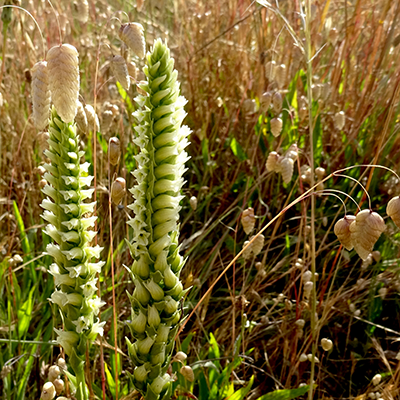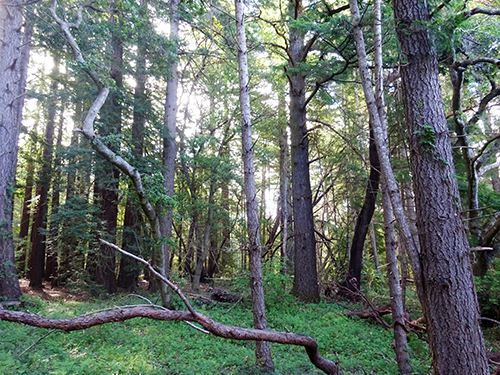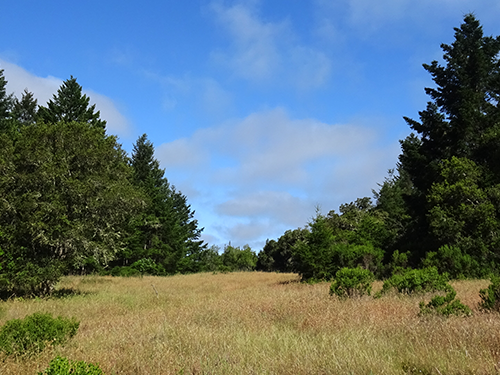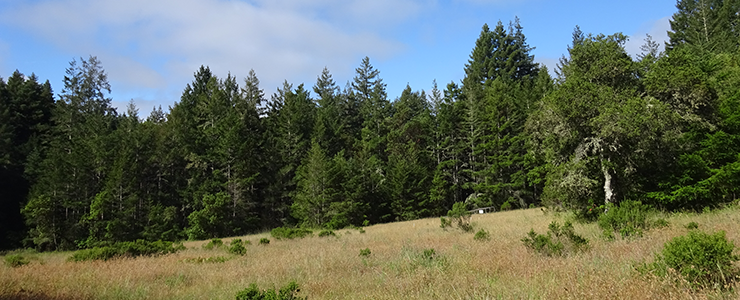West Marshall Field
West Marshall Field (74 acres)
 General Description: A mix of coastal prairie and mixed evergreen forest, this section of the reserve abuts Wilder Ranch State Park and features Mima mounds, a diversity of spring wildflowers, and a mixture of oak, Pacific madrone, coast redwood, and Douglas-fir.
General Description: A mix of coastal prairie and mixed evergreen forest, this section of the reserve abuts Wilder Ranch State Park and features Mima mounds, a diversity of spring wildflowers, and a mixture of oak, Pacific madrone, coast redwood, and Douglas-fir.
Geology: Though not as extensive or as well developed as that in southwestern corner of campus (the Mima Meadow, or Inclusion Area A), West Marshall Field includes areas of under-drained claypan soil that support a Mima mound-hogwallow-vernal pool habitat. This geologic anomaly is seen in many areas of the world, and there are many competing theories as to its origin. A recent publication in the peerreviewed journal Geomorphology details the computer modeling work of Gabet et al. (2014), who claim to have proven that the origin of Mima mounds can be explained by bioturbation caused by fossorial mammals, such as gophers, seeking drier, higher ground during times with seasonally saturated soils. The Mima mounds appear as small hillocks, between which occur depressions, or hogwallows. In Inclusion Area A, the largest of the hogwallows sometimes retain winter rain, creating vernal pools which drain very slowly, due to the impermeable claypan soil layer underlying the area. The vernal pools support a specialized, successional flora, which changes as the pools dry. According to Stone (1983), the vernal pool plants must be able to sprout, grow, flower, and set seed in a very short period of time.
Plants: Roy Buck, a campus botanist who conducted a botanical survey in Inclusion Area A, states that the coastal prairie community thatoccupies the hogwallows is a high-quality  example of a plant community that is declining statewide (Buck 1983). Although once widespread, the coastal prairie community has been “…reduced to a fraction of its former area since European settlement” (ibid.). Portions of West Marshall Field fall into this category as well.
example of a plant community that is declining statewide (Buck 1983). Although once widespread, the coastal prairie community has been “…reduced to a fraction of its former area since European settlement” (ibid.). Portions of West Marshall Field fall into this category as well.
The coastal prairie community should be of special interest to students and faculty studying California native plants. Apparently, introduced species do not compete as well in the vernal pools as they do in other campus grasslands, and thus the coastal prairie supports a high diversity of native species. Natives formerly found in abundance include California oatgrass (Danthonia californica), toad rush (Juncus bufonius), western rush (Juncus tenuis var congestus), and keeled club rush (Isolepis carinata). A number of significant species occur in the coastal prairie community, including Gairdner’s coast yampeh (Perideridia gairdneri ssp. gairdneri) which is listed by the California Native Plant Society (CNPS 2011) as fairly endangered in California (status 4.2). Other significant species found in the grasslands around Marshall Fields are listed in Appendix B.
Animals: In Inclusion Area A, as recent as the early 1980s, the mima mounds, vernal pools, and grasslands supported a number of animal species of interest to individuals and classes studying terrestrial vertebrates and invertebrates. The vernal pools are especially attractive to wildlife, according to Roger Luckenbach, a former natural history professor at UCSC who conducted a faunal analysis for a proposed research and development center. He stated, “Grassland seeps and vernal pools are favorite foraging areas for many avian species, breeding sites for amphibians, and drinking holes for larger mammals” (Luckenbach 1983). Marsh and wading birds, including killdeer, snipe, and greater yellowlegs, were attracted to the vernal pools—there are very few other on-campus sites that can support these and other species dependent on riparian habitat.
 Management: Edges of the coastal prairie are mowed annually by the UCSC Grounds Department. Management opportunities included prescribed fire, which is used in adjacent prairie by Wilder Ranch State Park.
Management: Edges of the coastal prairie are mowed annually by the UCSC Grounds Department. Management opportunities included prescribed fire, which is used in adjacent prairie by Wilder Ranch State Park.
Opportunities for teaching, research, and stewardship: This is the most remote section of the CNR, and is too far to bring students to during a typical 1 hour 10 minute or 1 hour 45 minute class period without transportation. This restricts the educational uses of the parcel to classes that are longer, such as ENVS 15 (Natural History of the UCSC Campus) or ENVS 107ABC (Natural History Field Quarter, for example. Field labs for BIOE 177L (Systematic Botany of Flowering Plants Lab) do transport their students to Marshall Fields for a 2 hour section using vans. Opportunities for research include small mammal trapping and vegetation studies. Stewardship opportunities include the following. Unauthorized bike paths lead through forested sections of the parcel; trail closures and maintenance are needed in this area. Several invasive plant species are established along Empire Grade, which forms the eastern border of this parcel, and forested areas adjacent to the road. The Federally Endangered Ohlone tiger beetle (Cicindela ohlone) occurs in nearby meadows in both Wilder Ranch State Park and UCSC’s Lower Marshall Field. It’s possible that maintaining the dirt trail leading from the Empire Grade pull-outs to Chinquapin Fire Road could maintain habitat that OTB could potentially occupy. Carefully prescribed fire could limit forest intrusion and lower thatch build-up from nonnative grasses.

